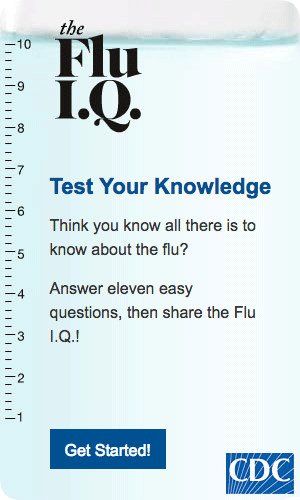
The Flu I.Q. widget is an interactive quiz to test your flu knowledge. https://www.cdc.gov/flu/freeresources/widgets/fluiq/index.html
During the severe 2017–2018 influenza season, vaccination is. . . estimated to have prevented 7.1 million illnesses, 3.7 million medical visits, 109,000 hospitalizations, and 8,000 deaths, despite an overall estimated vaccine effectiveness of 38% (Grohskopf et al., 2020).
Influenza is one of the deadliest viruses in the world, yet we take for granted that we are protected from its ill effects. We are deathly afraid of other viral infections, any of which kill only a fraction of the people that die each year from influenza. Yet many of us skip our annual flu shots, giving various excuses for forgoing the vaccine. This is despite the fact that the impact of influenza is enormous—estimated to be about 1 billion cases worldwide with death in nearly half a million people.
The 2017–2018 influenza season was severe, with high levels of outpatient clinic and emergency department (ED) visits for influenza-like illness (ILI), high influenza-related hospitalization rates, and elevated and geographically widespread influenza activity for an extended period. In 2017 the Centers for Disease and Prevention (CDC) began using new methodology to classify seasonal severity and applied the methodology to the 2003–2004 through 2016–2017 seasons. The 2017–2018 season was the first season to be classified as high severity across all age groups (CDC, 2019q).
The 2018–2019 influenza season was of moderate severity and differed from recent seasons in that there were two waves of influenza A activity of similar magnitude. It was also longer than recent seasons with activity at or above baseline for 21 consecutive weeks. Overall, hospitalization rates were below those of the previous season, but rates for children under 17 years of age were similar to the previous year (Xu et al., 2019).
The 2020–21 influenza season will coincide with the continued or recurrent circulation of SARS-CoV-2 (the novel coronavirus associated with COVID-19). Influenza vaccination of persons aged ≥6 months to reduce prevalence of illness caused by influenza will reduce symptoms that might be confused with those of COVID-19. Prevention of, and reduction in, the severity of influenza illness and reduction of outpatient illnesses, hospitalizations, and intensive care unit admissions through influenza vaccination also could alleviate stress on the U.S. health care system (Grohskopf et al., 2020).
Influenza is a clever virus—it shifts, drifts, and adapts, every so often mutating into a virus to which humans have little or no immunity. When this happens, a pandemic can occur, as in 1918 when a devastating influenza pandemic killed tens of millions of people throughout the world. Some of us lost grandparents, aunts, or uncles to the 1918 pandemic. All influenza A pandemics since that time, and almost all cases of influenza A worldwide, have been caused by descendants of the 1918 H1N1 virus (Taubenberger & Morens, 2006).

One hundred years ago the 1918 influenza pandemic devastated entire communities and took an estimated 675,000 American lives. It was the most severe pandemic in recent history, sweeping the globe quickly and killing more than 50 million people. Source: CDC.
Online Resource
Video: 1918 Pandemic (1:31)
https://www.cdc.gov/flu/pandemic-resources/1918-commemoration/index.htm
Even if you are not familiar with the 1918 pandemic, you may be aware of the 2009 H1N1 pandemic—the first global influenza pandemic in more than forty years. It was caused by the emergence of a novel* H1N1 influenza strain that reminded us just how serious an influenza pandemic can be. By the time the World Health Organization (WHO) declared the pandemic officially over in August 2010, the CDC estimated that 43 to 89 million people in the United States had become infected and more than 12,000 had died. It is estimated that worldwide between 151,700 and 575,400 people died from 2009 H1N1 virus infection during the first year the virus circulated (CDC, 2018d).
*Novel: New (novel) influenza viruses are different from those currently circulating. This can include highly pathogenic influenza A viruses (H1N1, H5N1, H7N3, and H7N9).
Influenza experts believe that another influenza pandemic will occur—likely caused by an influenza subtype to which there is little or no pre-existing immunity in the human population. Even though the H1N1 pandemic of 2009 is officially over, the H1N1 virus continues to circulate as a seasonal virus and is expected to do so for several years. Fortunately, most (although not all) countries have developed influenza vaccines that protect against the H1N1 virus.
